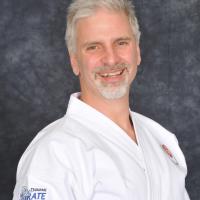Before you are through being a White Belt, you will already be required to have competence in four stances, four blocking techniques, six strikes, and four front kick variations. There will be moments when this eighteen-item checklist will seem like an overwhelming amount of material to swallow in a very short period of time.
There are, however, a few key qualitative generalizations to be made about virtually all techniques. As you enjoy class training in kihon (technical fundamentals), you'll want to continually check the following seven preliminary items to ensure they are driven deeply into your muscle memory. Your ability to grasp them will make it easier to develop effective karate. They are presented in the order in which most students are able to develop awareness of them, not in order of their importance. For now you should consider them equally important, which is why they're not numbered.
• The physical aspect of your karate always begins with your stance. Of these seven, it is the one aspect that will most determine the effectiveness of your technique, so be attentive to the details.
• Next is the chosen technique. Even if it feels strange or ineffective to you at first, make no assumptions as your sensei or sempai shows you how to perform a new move. Be a blank slate and learn properly from the start.
• Half-face or straight-face—you'll hear one of these terms constantly as you learn to orient your body for the proper application of defense or offense, respectively. Rotating into a half-faced position draws your vital organs away from your attacker, brings increased power to the blocking technique, and prepares you kinesiologically for the delivery of a powerful counterattack. Rotating into a straight-faced position enables maximum concentration of power. It is important that your stance places your feet at hip's width, as described earlier, so your hip has adequate range to easily rotate between straight-face and half-face.
• The draw hand, or hikite—that is, the opposing hand from the technique hand, drawn to the hip as the basic strike or block is deployed. This is the aspect of technique most oftenoverlooked by beginning students. What senior students understand, however, is that virtually all techniques make use of the entire body, and are expressed with both hands. An improper draw hand robs much of the power from the technique being applied by the other hand. Indeed, your draw hand should be snapped back with exactly the same energy that is applied to the technique itself. With your elbow remaining close to the body, your fist draws back, fully rotated, ending just above your belt. When in a half- face position, strive for your forearm to end perpendicular to your line of travel.
• Regardless of the position of your body, it is important to keep your head forward. The generation of power promised by Shotokan Karate requires relaxation in the parts of the body not being used. Keeping your head relaxed (inside and out!) can save your life. You'll hear, "Look first!" when you turn from one direction to another, and you must be relaxed to observe a threat as quickly as possible. This behavior is seen when a cat stalks its prey. Regardless of the movement of its body, its head remains steady, enabling it to take full advantage of its stereoscopic vision by keeping both eyes equally distant from its target. You must do this as well.
• Your capacity to keep your gaze on your opponent's eyes could make the difference between surviving an attack and being overcome by one. Many of us find it hard to look steadily into another person's eyes, which can be uncomfortable. But in my dojo we practice it and overcome that discomfort as we develop this vital skill. Master Hirokazu Kanazawa described it as necessary for knowing what your opponent will do in a fight before he does it. Through your opponent's eyes, Kanazawa said, you learn to become his mirror and therefore come to see that he is not your antagonist at all—an empowering concept. When you face a partner, the best method is to simply look at his eyes without thought. This best enables you to see who that person truly is and communicates your steadfastness to him. If that makes you feel uncomfortable, start with one eye or the other, or simply focus on the bridge of his nose. Always practice this gaze in your mind when you face forward in class and, whenever possible, when you look into the eyes of an opponent.
• Often, the last thing beginning karateka accomplish in their initial development is to get their shoulders relaxed. Relaxation is absolutely fundamental to self-defense and to the generation of power. Hunched shoulders are normally the first indicator that you are too tense but watch for tension in any part of your body. Bring relaxation to this one place, and all of karate will become immediately easier to practice. You'll feel your entire body ease, and you'll actually find comfort in your training.
Quick Self-Training Tip
Here's a reliable way to discover which of the "corners" of your feet takes more weight than it should. Tape a few sections of 1/2" bubble wrap to the floor. Rather than doing what you want to do, try walking across it, slowly, striving to not pop a single bubble. Only by balancing your weight across each foot can you achieve this as you step.


